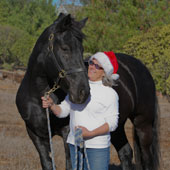
Grace Shumate rides 'Rick' along with (from left) Amber Paciatto, Kristin Moore and Ingrid Mourey.
It’s here, on horseback, where gifts are exchanged all year long. Since 1981, the special students, their families, the horses, the staff, the volunteers–have enriched each other’s lives together at R.E.I.N.S., an acronym for Riding Emphasizing Individual Needs and Strengths.
“When people see this, they want to be part of it,” says Debbie Shinner, who arrived as a volunteer in 1992 and has been the Executive Director through 16 years of growth. “Just more and more students have been coming because they’ve heard. When parents find a therapy that works with their children or adults, they will travel to the moon and back.”
A decade before Shinner arrived, R.E.I.N.S. began in the hands of another Debi, Debi Ruth Parker. After earning a Master’s Degree in Special Education, Parker moved to San Diego County and taught the visually impaired in Vista. In 1979, she helped co-found a program at the Helen Woodward Animal Center which originally was called the Animal Care and Education Center.
“I was new to the area and talking about my work to someone who said, ‘wow, wouldn’t it be cool to teach riding to the disabled!”, remembers Parker, known then as Debi Young. “I said, ‘whoa’–that’s two things that I love, working with the disabled and teaching riding because I had done that for years.”
A small program began, and Parker earned her certification as a North America Riding for the Handicapped Association instructor. She envisioned a larger program, and shortly thereafter R.E.I.N.S. was born on her property in a secluded plateau above San Marcos, where she still resides.
“The first program did not want to expand, and I thought, ‘well, there are too many in San Diego area that could benefit’,” she says. “So we expanded the program, and it grew and grew into what it’s become now.”
And it has grown everywhere. When Parker earned NARHA certification, she was one of 30 certified NARHA trainers. Almost 30 years later, there are 637 NARHA riding programs, and R.E.I.N.S. ranks in the top 10 percent with an annual budget of more than $500,000. Parker says therapeutic programs have penetrated the mainstream equestrian scene, too, with handicapped classes at a growing number of horse shows. Breed organizations also are aiding participation: The American Quarter Horse Foundation and Farnam have teamed up to sponsor the “Because Of A Horse” program.
The secret of the success is simple, Parker says. Everyone wins in therapeutic riding therapy. And these victories are life-changing–for everyone.
After riding most of her life, including a year of formal horse masters education in Britain after high school and years as a trainer at Portuguese Bend in Rancho Palos Verdes, Parker remembers her first session with the handicapped.

R.E.I.N.S. founder Debi Ruth Parker of San Marcos, here with her daughter’s horse, Sami, began the program almost 30 years ago.
The gift starts with the horse. The passive ride on a horse’s back is the closest anyone can get to walking in a non-weight-bearing state. It has the same three natural movements–forward-and-backward, side-to-side, and up-and-down–that we have when walking.
“Even if you’re not doing anything cognitively, the horse is affecting your whole body,” Parker says. “You’ll hear stories about kids–‘my child finally spoke for the first time because
of riding.’ Well, that movement stimulates the speech area of the brain, and so, yes, a lot of kids do talk for the first time after they’ve been riding.”
The power of riding therapy gets amplified when other therapies fall short. Parker remembers a young 9-year-old girl unable to see, hear or talk. The girl lived without “references”–she could not distinguish days from nights, and her parents resorted to measures like cold showers during the day, so she would not sleep until nighttime.
After several months of lessons, the parents went to the girl’s room before her Saturday morning lesson and were astounded by what they saw. Their daughter was dressing herself, pulling on her jeans and boots.
“You have to know that the riding was significant enough to her that she could keep track of the days of the week in whatever ways she could and know that it was her day to ride,” says Parker.
“It’s a gift for everybody,” she adds. “The horses benefit, too. Lots of times there are horses that are being retired, and yet can still keep giving and get incredible care at these facilities. It’s a win-win situation, every angle. It’s just amazing. And age doesn’t matter. When they get involved with animals, the animals are non-judgmental. And they start to feel the acceptance and they reach out. All of a sudden, they are reaching out to people, too.”
Today’s R.E.I.N.S. team reaches out from the Fallbrook facility, which it purchased 10 years ago. Shinner says volunteers don’t require horse experience, but they must be at least 12 years old.
“The exciting part of that is that after they volunteer here, they stay,” says Shinner. “They don’t go. It’s neat that you can possibly influence their lives. The depth of this program is so tremendous that we provide the home for older therapy horses–the older horses–but we also have this volunteer base that we can hopefully sometimes change someone’s life.”
As a non-profit organization that receives no federal or state funding, R.E.I.N.S.’s growth hinges on donors who can sponsor a child, a horse or make a straightforward cash donation.
Leave a Comment
All fields must be filled in to leave a message.